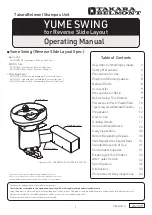
OM-235 368 Page 12
3-8. Checking The Helmet Cooling System Before Use
Read and follow
.
these instructions
and the safety labels
carefully. This
product is intended
for use as a cooling
device only. It is not a
respiratory protec-
tive device and does
not protect the user
from airborne con-
taminants. Have an
industrial hygienist
test the air in your fa-
cility to determine if
respiratory protec-
tion is required to
provide adequate
protection from con-
taminants in your en-
vironment. With cool-
ing system-equipped
helmet on your head
and cooling system
operating, also test
the air inside the hel-
met to determine if
respiratory protec-
tion is required. If you
have questions about
the type of respirato-
ry protection equip-
ment required, con-
sult your safety direc-
tor and an Industrial
Hygienist.
Do not restrict or alter
.
helmet cooling sys-
tem air flow. Be sure
safety glasses, hair,
weld cap, and other
objects do not block
air flow.
Before using the helmet
cooling system, check the
following items:
1
Filter And Spark
Guard (Section 3-5)
.
Filter is required for
proper operation of
equipment, but does
not provide respiratory
protection.
Verify the filter and spark
guard are undamaged,
properly assembled, and
securely connected to the
blower assembly.
2
Flexible Hose (Section
3-6)
Be sure the hose is undam-
aged and properly con-
nected to the blower as-
sembly and shroud.
3
Battery (Sections 3-3
And 3-4)
Verify the battery is fully
charged and securely in-
stalled in the blower assem-
bly.
4
Air Flow (Section 3-7)
Turn on blower assembly
and test air flow at low and
high speeds.
5
Shroud (Section 3-2)
Inspect the shroud and re-
place if damaged. See
Troubleshooting (Section
3-13) if air is not being sup-
plied to front of helmet.
Put on helmet and adjust
helmet so helmet fits snugly
on head. Verify shroud is
properly installed on hel-
met.
.
See the welding helmet
Owner’s Manual for
helmet adjustment in-
formation.
6
Fabric Shroud
(Section 3-2)
Inspect the shroud and re-
place if damaged. See
Troubleshooting (Section
3-13) if air is not being sup-
plied to shroud.








































